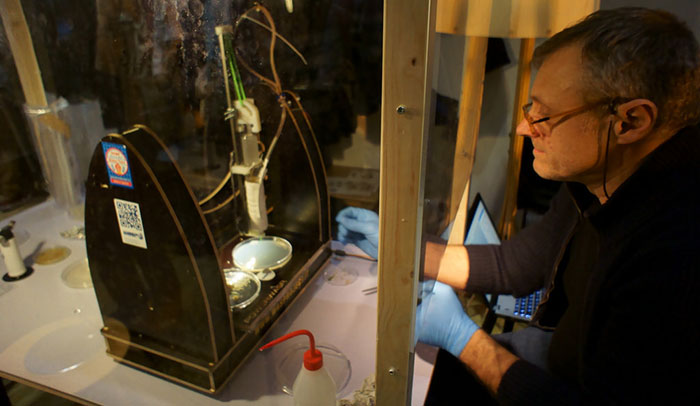Founded by Massimo Moretti, one of the most charismatic people I have ever met, WASP (the World’s Advanced Saving Project) is undoubtedly a major contributor to the Italian 3D printing and Maker scene. WASP has developed both a Cartesian machine and a very precise Delta 3D printer and never stops innovating them, injecting any and all profits made from sales directly into its Research & Development activities.
WASP’s Delta platform is also capable of 3D printing with ceramics and Moretti, whose business card says “Dreamer”, dreams of one day using it to solve the world’s housing problems in a sustainable way. In the meantime, though, WASP always keeps trying new things and, for the “Bio-Logic” project organized by Co-de-iT (Tommaso Casucci and Mirko Daneluzzo), Waag Society, Sonja Bäumel and Maurizio Montalti’s Officina Corpuscoli design studio, the company recently visited the Amsterdam FabLab and 3D printed with agar, a particular biomaterial used for feeding and growing micro-organisms.

While many people go to Amsterdam to play with a different type of mushroom, WASP’s team used the agar to grow a particular slime-mold fungus that “redefines intelligence” as it has no brain but, when it goes looking for food, it seemingly always ‘knows’ the right direction to go in.
For the experiment WASP used its PowerWASP EVO Cartesian machine modified with a nozzle capable of extruding fluid-dense materials developed directly by WASP’s founder Massimo Moretti, with specifically modified software developed by Tommaso for generating G-code.
Professor Marinella Levi of Milan Politecnico’s +LAB, in the University’s Chemical Department also participated in the project which she described and explained to me enthusiastically when I met with her at Eurostampi in Parma, where the Politecnico’s 3D printing laboratory was exhibiting some of its work experimenting with different materials for FDM.
“We deposited organic material in a controlled manner, using software developed by Tommaso Casucci of Co-de-iT Group,” she told me. “The Slime mold was thus ‘invited’ to follow a specific trail. The results were quite impressive, as the slime-mold fungus followed the organic material, structures crystallized into amazing looking geometries.”


